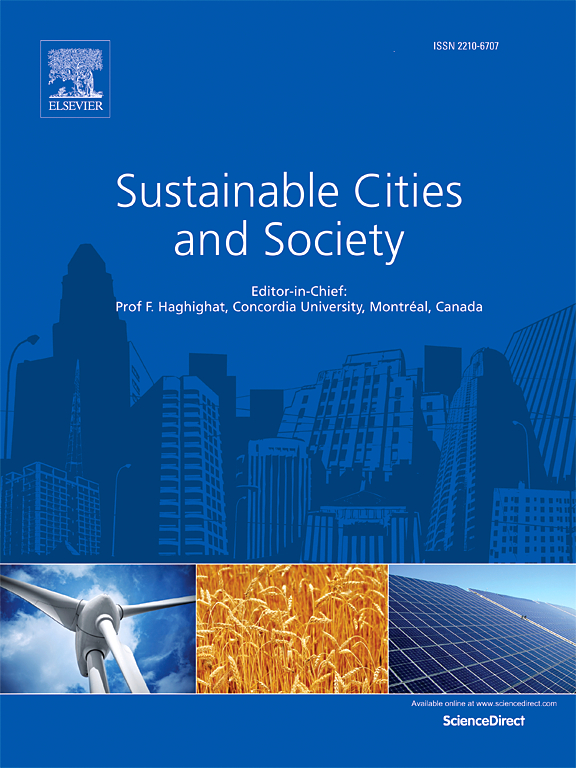Exploring the decoupling evolution of carbon emissions from economic efficiency in the construction sector: a comparative perspective
IF 10.5
1区 工程技术
Q1 CONSTRUCTION & BUILDING TECHNOLOGY
引用次数: 0
Abstract
Research on the decoupling evolution of carbon emissions from economic efficiency (EE) is essential for advancing decarbonization in the construction sector. While previous studies have extensively investigated the decoupling of total carbon emissions (TC), per capita carbon emissions (PC), and carbon intensity (CI) in isolation, they often neglect comprehensive analysis. This gap hinders a nuanced understanding of the decoupling status within the construction sector, as each parameter—TC, PC, and CI—provides unique insights. Therefore, this work contributes to this gap by developing a comparative perspective on the decoupling trajectories for TC, PC, and CI. This holistic comparison will illuminate the dynamics and distinct roles of these parameters in the decoupling process from EE, providing rounded insights into the sector’s decoupling status by considering cumulative emissions, workforce practices and emission efficiency. Using the Tapio decoupling model and Generalized method of moments (GMM) estimation, the empirical analysis examined the decoupling status of the construction sector across 30 Chinese provinces from 2012 to 2021, yielding the following key findings. Firstly, the decoupling performances for TC, PC, and CI indicate general improvements, with an exception of 2019. Spatially, the decoupling for TC, PC, and CI exhibits similarities, with strong decoupling (SD) primarily occurring in eastern provinces while strong negative decoupling (SND) concentrated in western provinces. Secondly, CI is likely to be the leading parameter to achieve SD, relative to TC and PC. Furthermore, the GMM estimation reveals inverted N-shaped patterns in the decoupling of TC, PC and CI. Lastly, this study provides policy recommendations to address the unique challenges faced by regions. Theoretically, this research enriches the discourse on carbon emissions in the construction sector and contributes to the field of economic geography. Practically, it aids policymakers in setting achievable carbon reduction targets and developing effective action plans.
建筑行业碳排放与经济效率的脱钩演化:比较视角
研究建筑行业碳排放与经济效率的解耦演化对推进建筑行业脱碳具有重要意义。以往的研究对碳排放总量(TC)、人均碳排放(PC)和碳强度(CI)的脱钩进行了广泛的孤立研究,但往往忽视了综合分析。这一差距阻碍了对建筑行业内解耦状态的细致理解,因为每个参数(tc、PC和ci)都提供了独特的见解。因此,这项工作通过对TC、PC和CI的解耦轨迹进行比较来弥补这一差距。这种整体比较将阐明这些参数在与能效脱钩过程中的动态和独特作用,通过考虑累积排放、劳动力实践和排放效率,为该行业的脱钩状态提供全面的见解。利用Tapio解耦模型和广义矩量法(GMM)估计,实证分析了2012年至2021年中国30个省份建筑业的解耦状况,得出以下主要发现:首先,除2019年外,TC、PC和CI的解耦性能总体上有所改善。在空间上,TC、PC和CI的脱钩具有相似性,强脱钩(SD)主要发生在东部省份,而强负脱钩(SND)集中在西部省份。其次,相对于TC和PC, CI可能是实现SD的主要参数。此外,GMM估计在TC, PC和CI的解耦中显示出倒n形模式。最后,本研究为解决各地区面临的独特挑战提供了政策建议。理论上,本研究丰富了建筑行业碳排放的论述,并对经济地理学领域有所贡献。实际上,它有助于决策者制定可实现的碳减排目标和制定有效的行动计划。
本文章由计算机程序翻译,如有差异,请以英文原文为准。
求助全文
约1分钟内获得全文
求助全文
来源期刊

Sustainable Cities and Society
Social Sciences-Geography, Planning and Development
CiteScore
22.00
自引率
13.70%
发文量
810
审稿时长
27 days
期刊介绍:
Sustainable Cities and Society (SCS) is an international journal that focuses on fundamental and applied research to promote environmentally sustainable and socially resilient cities. The journal welcomes cross-cutting, multi-disciplinary research in various areas, including:
1. Smart cities and resilient environments;
2. Alternative/clean energy sources, energy distribution, distributed energy generation, and energy demand reduction/management;
3. Monitoring and improving air quality in built environment and cities (e.g., healthy built environment and air quality management);
4. Energy efficient, low/zero carbon, and green buildings/communities;
5. Climate change mitigation and adaptation in urban environments;
6. Green infrastructure and BMPs;
7. Environmental Footprint accounting and management;
8. Urban agriculture and forestry;
9. ICT, smart grid and intelligent infrastructure;
10. Urban design/planning, regulations, legislation, certification, economics, and policy;
11. Social aspects, impacts and resiliency of cities;
12. Behavior monitoring, analysis and change within urban communities;
13. Health monitoring and improvement;
14. Nexus issues related to sustainable cities and societies;
15. Smart city governance;
16. Decision Support Systems for trade-off and uncertainty analysis for improved management of cities and society;
17. Big data, machine learning, and artificial intelligence applications and case studies;
18. Critical infrastructure protection, including security, privacy, forensics, and reliability issues of cyber-physical systems.
19. Water footprint reduction and urban water distribution, harvesting, treatment, reuse and management;
20. Waste reduction and recycling;
21. Wastewater collection, treatment and recycling;
22. Smart, clean and healthy transportation systems and infrastructure;
 求助内容:
求助内容: 应助结果提醒方式:
应助结果提醒方式:


